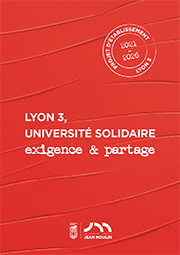AccueilRechercheProgrammes et productions scientifiquesThèsesThèses soutenuesThèses soutenues - 2022
-
Partager cette page
- Recherche,
- Droit,
GUEDON Pablo
Blockchain et droit fiscal
Thèse en Droit, soutenue le 5 décembre 2022.
Le système juridique ne considérant que ce qu’il qualifie, l’organisation des rapports intersystémiques passe nécessairement par la qualification de l’objet à appréhender. La présente étude propose ainsi une catégorie réceptionnant les blockchains, à laquelle est adjoint un régime mettant en ?uvre la technique juridique de l’assimilation pour déterminer le traitement fiscal de leurs applications. La démarche ne consiste qu’à étendre la méthode employée en droit fiscal positif pour imposer les entités issues d’ordres juridiques étrangers, inconnues du droit fran?ais. Les blockchains étant des systèmes juridiques tiers, la technique semble tout indiquée pour réceptionner les entités, valeurs et droits qu’elles font apparaitre. Le syllogisme à double détente, mis en place par la catégorie et le régime proposés, permet la saisie d’une réalité protéiforme selon une logique générale et cohérente, alors qu’elle apparaissait initialement rétive à toute appréhension globale. En outre, la généralité ne sacrifie aucunement la singularité des situations. Le traitement fiscal est différencié pour les applications différentes, mais également identique, pour chacune d’entre elles, aux entités du droit étatique auxquelles elles ressemblent le plus. La technologie, par son caractère normatif, ne fait que structurer des relations économiques aux visages multiples qui ne sont pas strictement identiques à celles qui recourent à d’autres solutions juridiques mais qui ne sont, pour autant, pas substantiellement différentes. La blockchain n’a pas créé de besoins nouveaux pour les individus et entités. Elle offre simplement des moyens alternatifs à l’organisation de rapports économiques, dont l’innovation repose généralement sur l’unique fait de se passer d’intermédiaires. Une telle approche du phénomène conduit ainsi à respecter le délicat compromis entre, la garantie des recettes de l’?tat, la sécurité juridique des contribuables, et la neutralité fiscale afin de sauvegarder leurs libertés.
Mots clés : Droit fiscal ; blockchain ; actif numérique ; crypto-actif ; bitcoin ; éther ; organisation autonome décentralisée ; smart contract ; sécurité juridique ; neutralité fiscale ; analyse substantielle ; assimilation.
The relationship between tax law and blockchain is turbulent. Each new asset or new economic relationship, resulting from the technology, seems to challenge this field of the law by the alleged breach with what existed before. However, this situation may be due to the reductionist approach that governs the understanding of the phenomenon. Considering only the applications of blockchain prevents a global grasp of this moving reality, in constant diversification, making the law powerless to face the appearance of each economic novelty. Conversely, the systemic approach offers an alternative reading prism that allows an overall understanding of the object under study. It leads the researcher to consider the blockchains themselves, without reducing them to their various economic applications, and to characterize each of them as an anational and aterritorial legal order bringing together a community of users. This renewed approach reveals that it is the norms of this legal system, and their ex ante sanction, that organize the new economic relations and lead the appropriation of new things of value – gathered under the generic banner of crypto-assets – that put pressure on the tax rules. Thus, the use of the systemic approach explains the infinite multiplication and diversity of relations, values, and entities that technology creates: the diversity of the norms of a legal system has no limit other than that which it sets. Therefore, blockchain’s economic applications, expected to diversify, may well continue to challenge tax law without the proposed paradigm shift. The resolution of current and future stumbling blocks depends on the understanding of the phenomenon in its generality, revealing the tax treatment of its various economic emanations, as and when they appear, according to a previously determined general logic.
Since the legal system only considers what it characterizes, the organization of inter-systemic relations necessarily involves the characterization of the object to be apprehended. Hence, the present study proposes a legal category for blockchains, to which is attached a regime implementing the legal technique of assimilation to determine the tax treatment of their applications. The approach simply consists of extending the method used in positive tax law for receiving and taxing foreign legal entities, unknown to French law. As blockchains are external legal systems, the technique seems to be ideal for receiving the entities, values, and rights that they create. The double-step syllogism, set up by the proposed category and regime, allows the seizure of a protean reality according to a general and coherent logic, when it initially appeared resistant to any global apprehension. Moreover, this generality does not sacrify the singularity of the situations. Tax treatment is differentiated for the different applications, but also identical, for each of them, to the entities of state law to which they most resemble. The technology, by its normative character, only structures economic relations with multiple faces which are not strictly identical to those which use other legal solutions but, which are, however, not substantially different. The blockchain has not created new needs for individuals and entities. It simply offers alternative means to the organization of economic relations, the innovation of which is generally based on the sole fact of not having intermediaries. Such an approach to the phenomenon thus leads to respecting the delicate compromise between the guarantee of the revenue of the State, the legal security of taxpayers, and tax neutrality in order to safeguard their freedoms.
Directeur de thèse : Georges CAVALIER
Membres du jury :
- M. CAVALIER Georges, Directeur de thèse, Ma?tre de conférence HDR, Université Jean Moulin Lyon 3,
- M. GUTMANN Daniel, Rapporteur, Professeur des universités, Université Paris 1Panthéon-Sorbonne,
- Mme PERIN-DURAU Ariane, Rapporteure, Professeure des universités, Université deStrasbourg,
- M. MIGNOT Marc, Professeur des universités émérite, Université de Strasbourg,
- M. CAUSSE Hervé, Professeur des universités, Université Clermont Auvergne, Clermont-Ferrand,
- Mme KOURALEVA-CAZALS Polina, Professeure des universités, Université SavoieMont-Blanc, Chambéry.
Président du jury : Hervé CAUSSE







